Ashitaba: Japan’s Resilient Herb for Flavor and Vitality
Mar 07,2019
Ashitaba: Japan’s Resilient Herb for Flavor and Vitality
Mar 07,2019
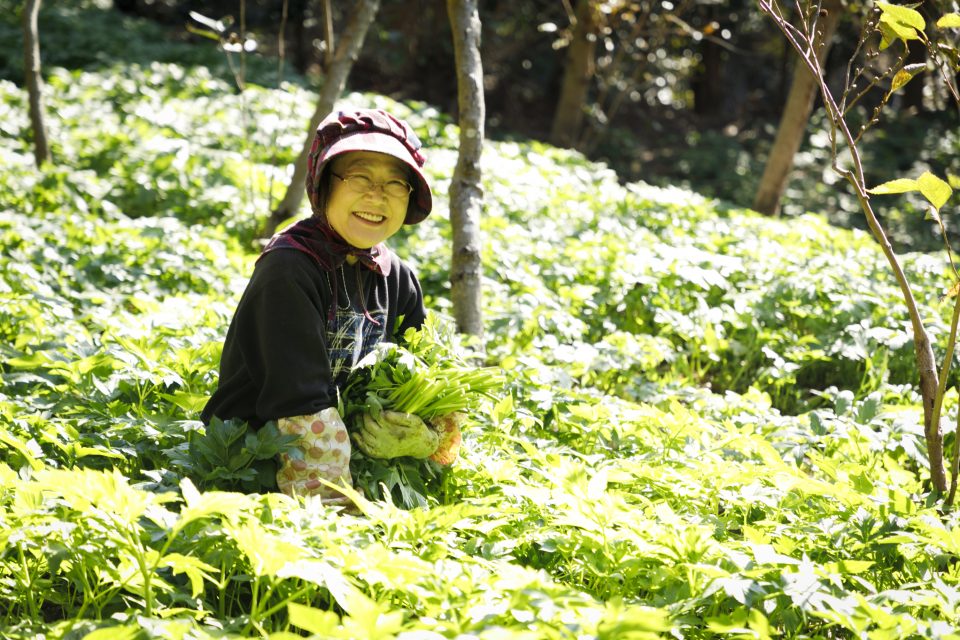

With a slightly bitter taste and a pleasing aroma, ashitaba [which literally means tomorrow’s leaf] is a herb-like plant native to Japan that grows wild in the Izu Islands. When visiting Izu Ohshima, you’ll not only find ashitaba on dining tables but also spot its robust leaves sprouting everywhere … in the gardens of private homes, by the ports, on the grounds of shrines, and around fields. You might think people simply pick some nearby ashitaba to use in their cooking, but there are actually farmers who cultivate ashitaba in fields. We had anticipated wild-looking fields, but instead what we saw was a beautiful, intricate paradise of ashitaba plants unfolding before our eyes.
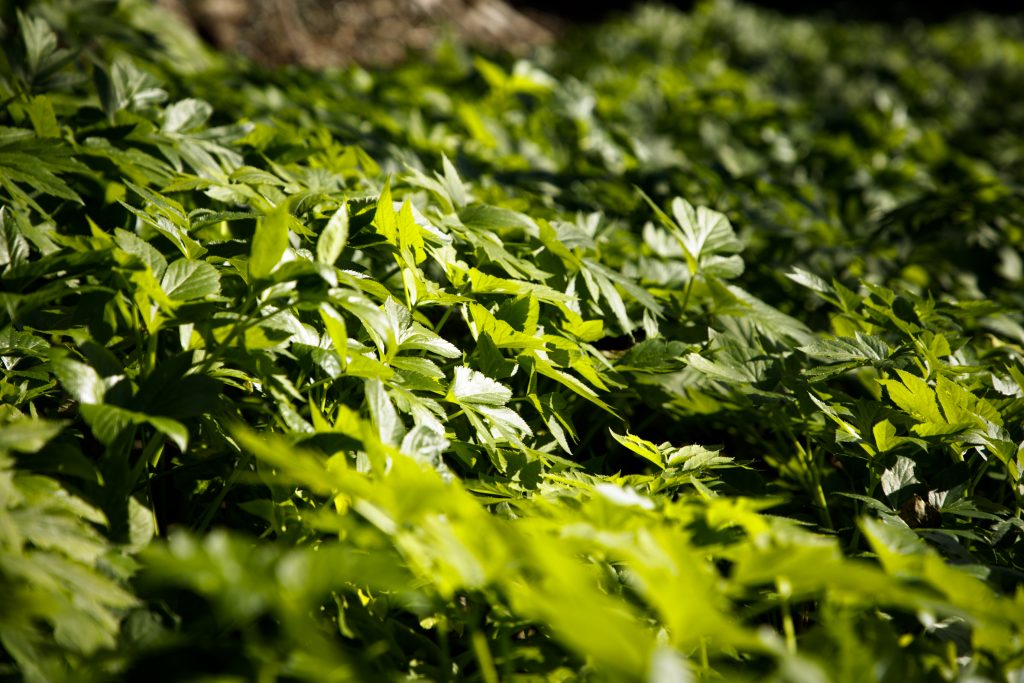
Imura’s ashitaba field is located on a sunny slope. Seeing the leaves stretch out toward the sun is a reassuring sight.
As mentioned in previous installments, growing crops on Izu Ohshima is not straightforward. The island has no fertile soil rich in nutrients, nor does it have reservoirs to store water or large rivers. Despite these challenging conditions, ashitaba natively grow thickly on the island.
“I used to work at a company in Tokyo. When I was about to retire, someone suggested I try growing ashitaba on Izu Ohshima. My husband immediately said ‘Let’s do it!’ I’ve always loved working in the fields, after all.”
Imura Kasuko, an ashitaba farmer, speaks to us in a nonchalant manner.
She comes from a family of farmers, who grew snow peas and flowers, so she already had the farmland. The community encouraged her to focus on cultivating ashitaba as a local Izu Ohshima crop. Her husband, who is also from Izu Ohshima, was very enthusiastic and returned to the island first to start working on the farm. “We had no choice but to go for it,” she says, explaining how she became an ashitaba farmer.
But what is it like to grow ashitaba? Since it grows wild everywhere, it would seem rather easy to grow. Our conversation with Imura soon corrected our misconception.
“Ashitaba plants grow slowly over the cold winter, but once spring comes, they grow really fast. New buds start to emerge the day after you’ve picked the leaves, which means we are always scrambling to keep up with the harvesting. You have to plan your harvesting carefully. Otherwise the leaves grow too large and become tough. You also have to avoid picking the buds. And during dry periods, you have to irrigate the plants daily.”
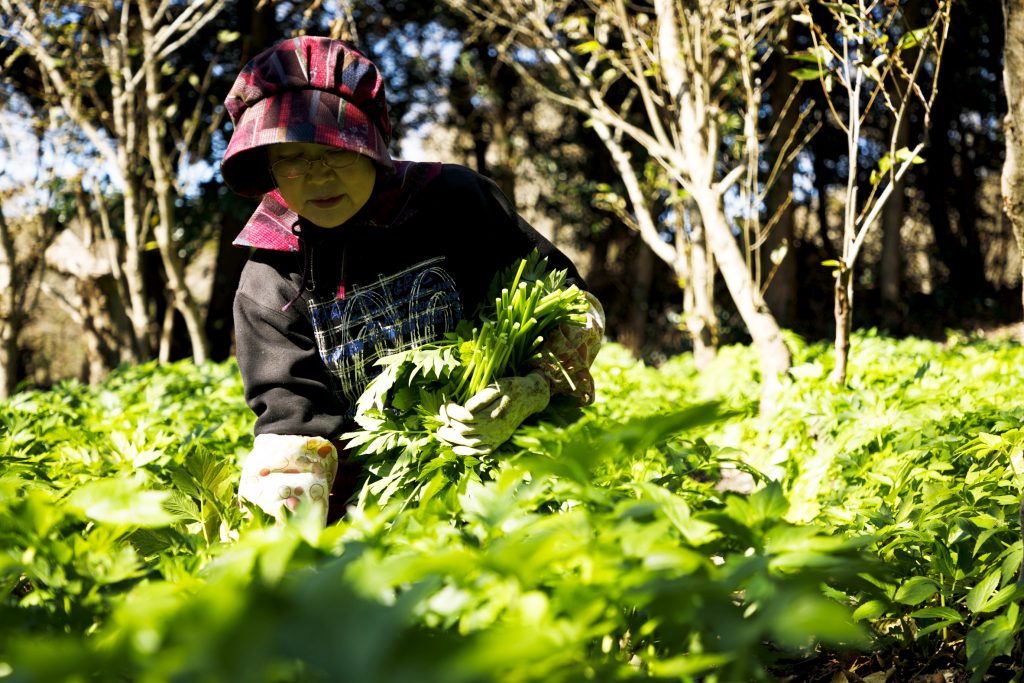
Harvesting takes place in the mornings. The work is harder than we imagined because it involves kneeling for long periods of time. During the peak season in spring, the work of bagging the leaves can go on until 2 or 3 a.m.
Looking across the ashitaba field, you can barely make out a series of overgrown rows. Instead of growing straight up, the ashitaba plant tends to let its stems and leaves droop and spread out. The pathways between the rows are almost hidden by the overflowing leaves. Dotted along the pathways are trees. To harvest the leaves, Imura kneels on the ground, being careful not to damage the ashitaba plants. She moves along between the rows, avoiding the trees in her path.
We remark offhandedly that the trees must get in the way. Without missing a beat, Imura replies. “Those are hannoki alders. We planted them to help the ashitaba grow better. Hannoki alders are deciduous trees, so in summer the leaves grow thick and provide shade, and in winter the leaves fall off, allowing the sunlight to reach the plants. The fallen leaves serve as natural fertilizer, and in summer the leaves protect the ashitaba, which are sensitive to strong sunlight. And the trees’ roots contain rhizobia, which are apparently beneficial for the growth of ashitaba.”
Rhizobia are a group of bacteria found in soil. They live in large numbers on nodules on the roots of hannoki alders and leguminous plants. Rhizobia take nitrogen from the air into the soil, convert it into ammonia, and supply it to plants. Nitrogen and ammonia are key fertilizers for growing crops. Producing ammonia, in particular, requires a high-energy chemical process that raises nitrogen to either high pressures or high temperatures. But rhizobia produce ammonia effortlessly while residing in the soil. In other words, rhizobia are natural fertilizer producers.
Ashitaba does grow in small vacant spaces and alongside houses. But in mountainous areas, the plants often grow thickly near hannoki alders. In a forest of hannoki alders with straight trunks, the lush green ashitaba plants covering the forest floor create a mystical scene. Imura’s field, which replicates this natural symbiosis and is meticulously maintained to cultivate even tastier ashitaba, is surely a paradise for ashitaba.
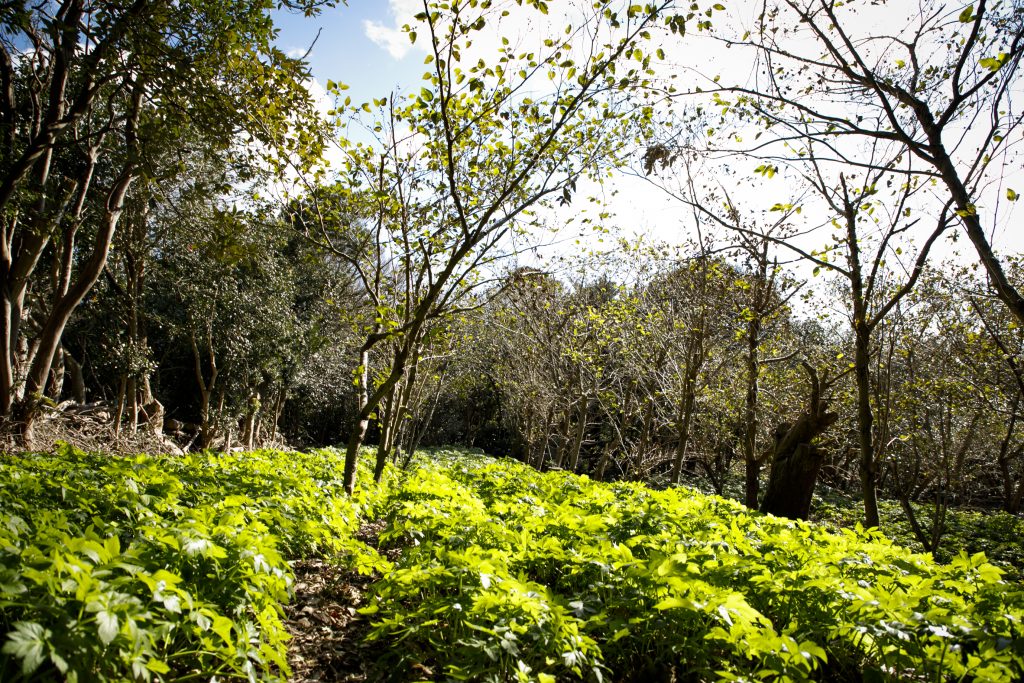
Hannoki alders grow in the middle of the field. The ground is covered in hannoki leaves.
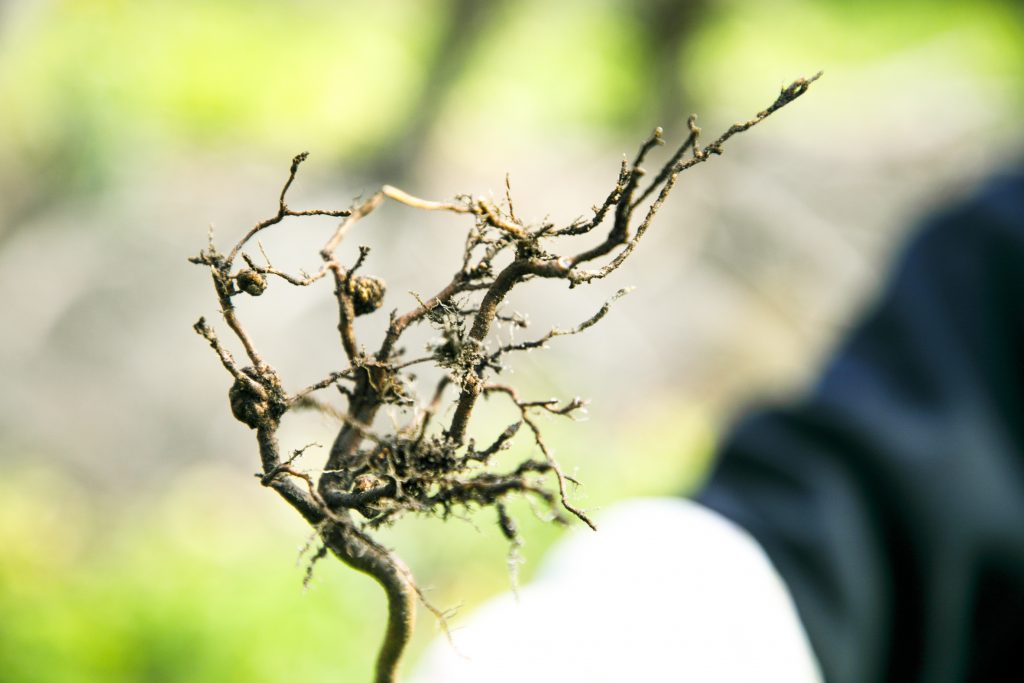
The nodules on the roots of hannoki alders are home to rhizobia. Rhizobia are also found in abundance on the roots of leguminous plants. The field, which used to grow snow peas, likely had a rich population of rhizobia. Now, they coexist with hannoki alders.
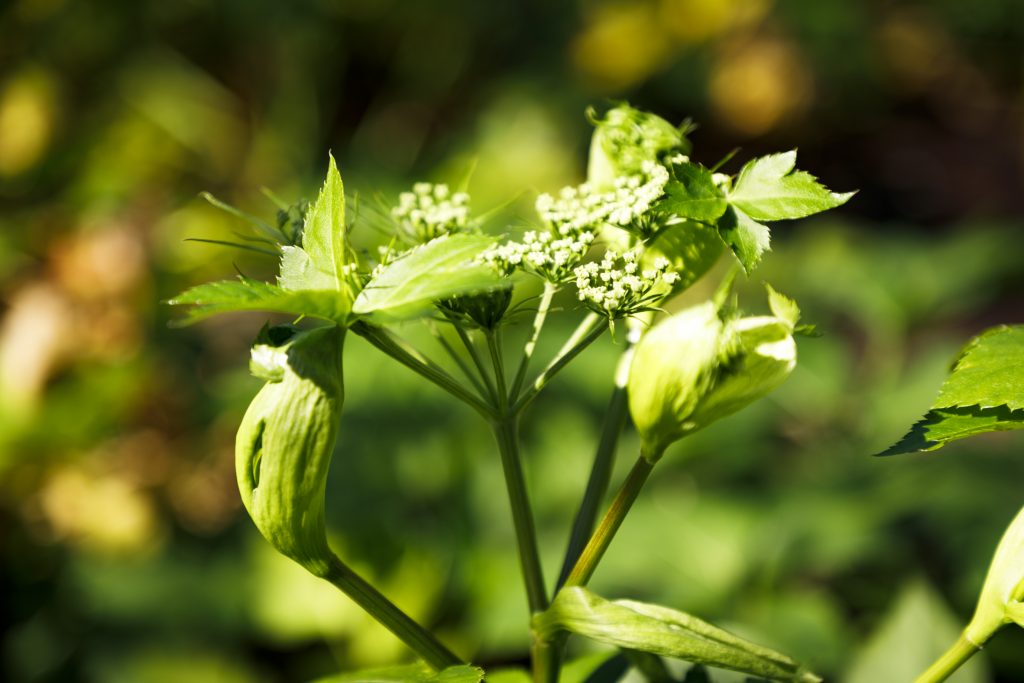
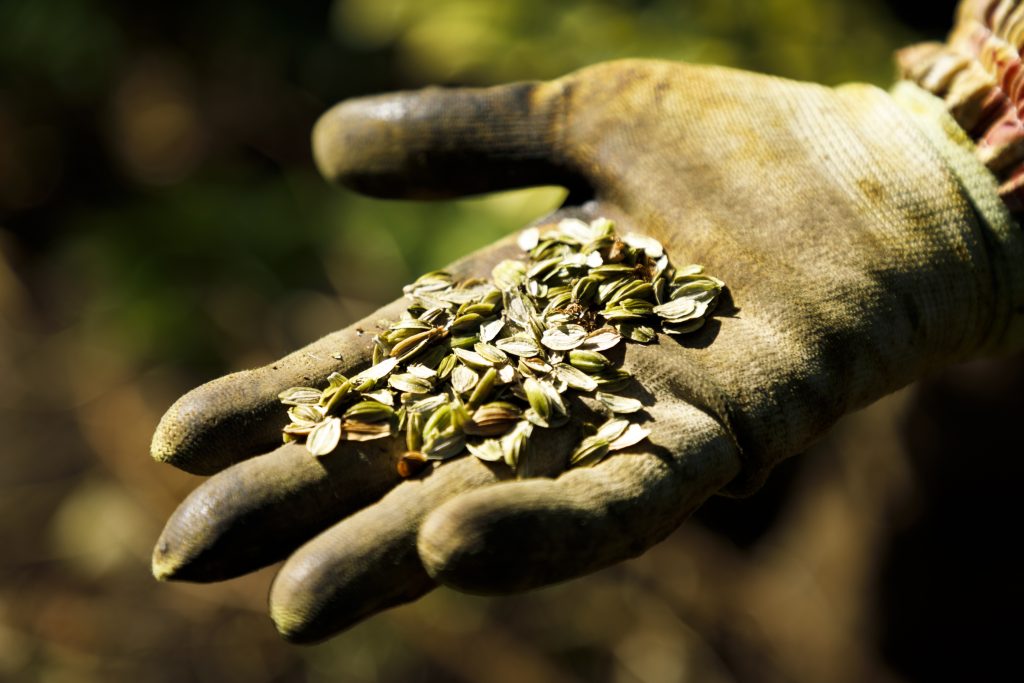
Ashitaba usually grow many small white flowers after three years, produce grain-like seeds, and complete their lifecycle. However, the plants live longer in Imura’s carefully tended field.
“Today, I’ll make around ten ashitaba dishes,” says Imura as she continues to harvest leaves. The work proceeds in almost dead silence. Kneeling in between the rows, she cuts with one hand the ashitaba at precise points with purpose-made scissors. In the crook of her other arm, she holds a large bundle of harvested ashitaba. It’s clear just how much concentration and physical strength harvesting requires. On her work clothes, we notice an unusual stain. They are not stained with soil.
“That is the chalcone that emerges when you cut ashitaba. Even with washing, it doesn’t come out. Over time, it turns pitch black.”
We touch an area stained with chalcone. It feels hard like pine resin or glue. What is this chalcone?
Imura shows us a cross-section of a cut ashitaba stem. A liquid that looks like yellow paint dribbles out. We taste a little and it’s quite bitter. But this is soon followed by the distinctive and refreshing ashitaba aroma. This is the real taste of ashitaba.
Chalcone is a type of polyphenol unique to ashitaba. Its characteristics include powerful antioxidant benefits, and numerous medical papers on chalcone have been published by pharmaceutical companies, university researchers, and food manufacturers. The papers describe chalcone’s antibacterial effects, anti-ulcer effects, gastric acid secretion inhibition, blood-thinning effects, anti-allergic effects, peripheral vasodilation effects, blood pressure-lowering effects, anti-diabetic effects, and prevention of metabolic syndrome. The diversity of its functions is astonishing.
Today, ashitaba juice, ashitaba tea, and ashitaba supplements are widely used in health foods and pharmaceuticals. However, using ashitaba for health purposes is not a recent phenomenon.
Qin Shi Huang, the first emperor of China, believed that ashitaba was a medicinal herb that gave perennial youth and long life, and he sent envoys all the way to Japan to obtain it. Ashitaba is listed in the Chinese herbal medicine compendium Bencao Gangmu compiled during the Ming Dynasty, and in Japan, the plant was described as a nourishing tonic in Yamato Honzo, a herbal medicine book written by Kaibara Ekken during the Edo period (1603 to 1868).

A cross section of ashitaba reveals the bright yellow chalcone, the source of the plant’s flavor and its health benefits
On Izu Ohshima, there are some interesting legends about ashitaba.
“In 1986, a massive volcanic eruption forced all residents to evacuate the island, and the scorching lava destroyed forests and fields. However, several months later, ashitaba plants were seen sprouting from the black lava. This is said to be a testament to the plant’s vitality.
“Although the island was covered in volcanic ash and green leafy vegetables could not be grown, the residents did not suffer from vitamin deficiencies or malnutrition because they regularly ate wild ashitaba.
“Long ago, there were dairy cows on the island that produced 75 liters of milk per day. Because these cows grazed on ashitaba, a tradition arose among women who had given birth to consume large amounts of ashitaba to produce more breast milk.
“Ashitaba are nicknamed ashitabo [which literally means ‘tomorrow’s spearheads’] on Ohshima. This name came about because the shape of young shoots look like spearheads pointing toward the sky. Another humorous name for the plant is chintachi-gusa [literally meaning ‘erect grass’], because of the shape of its young shoots and because of the belief that eating ashitaba enhances your sexual vitality.”
The quotation above is taken from Izu Ohshima Regional Resource Information Collection [Full Edition], published by the Ohshima Tourism Association.
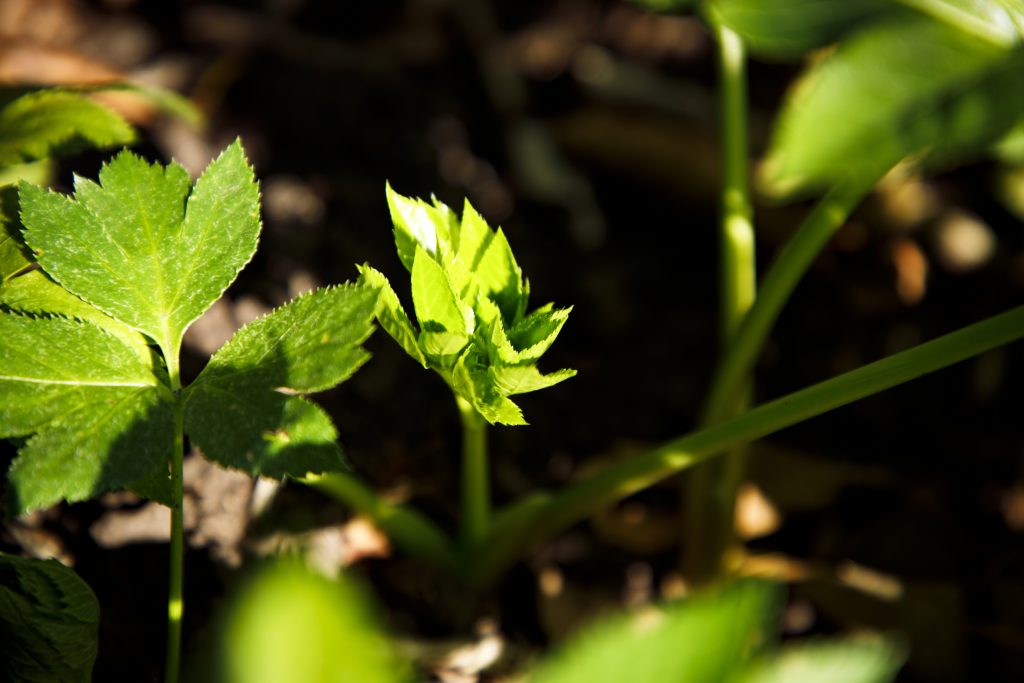
Young ashitaba shoots grow by gradually unfurling their heads. This appearance is why they are nicknamed ashitabo.
Finally the time came to make ashitaba dishes led by Imura.
“We’re having boiled ashitaba with soy sauce, two types of ashitaba with dressing, my go-to ashitaba stir-fry, mixed ashitaba and seafood tempura, ashitaba fried rice, ashitaba wrapped in meat, ashitaba soup, and ashitaba donuts. Let’s get to work. First, heat up some water and boil the ashitaba.”
At Imura’s call, we start cooking. Imura is an advocate for ashitaba cooking. To spread the message of how delicious Izu Ohshima ashitaba is, she holds tasting events and teaches original ashitaba recipes to nutritionists who make the school lunches on the island.
“The first step is to boil the ashitaba. Boil plenty of water and boil the ashitaba for four to five minutes. That’s just a rough guideline. The leaves are sometimes tougher than the stems, so check both the stalks and the leaves to determine whether it’s cooked.”
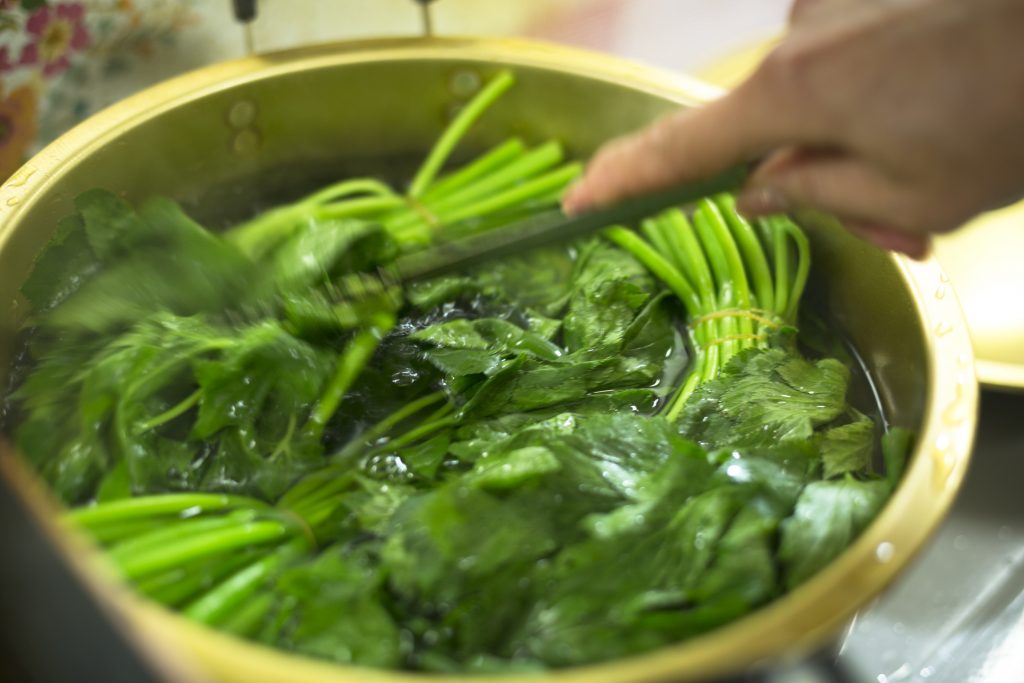
Once boiled, thoroughly rinse the ashitaba in cold water and then squeeze out the excess water. Boiling in bundles tied with rubber bands makes it easier to separate the stems and leaves. This also simplifies making boiled ashitaba with soy sauce, which uses only the stems.
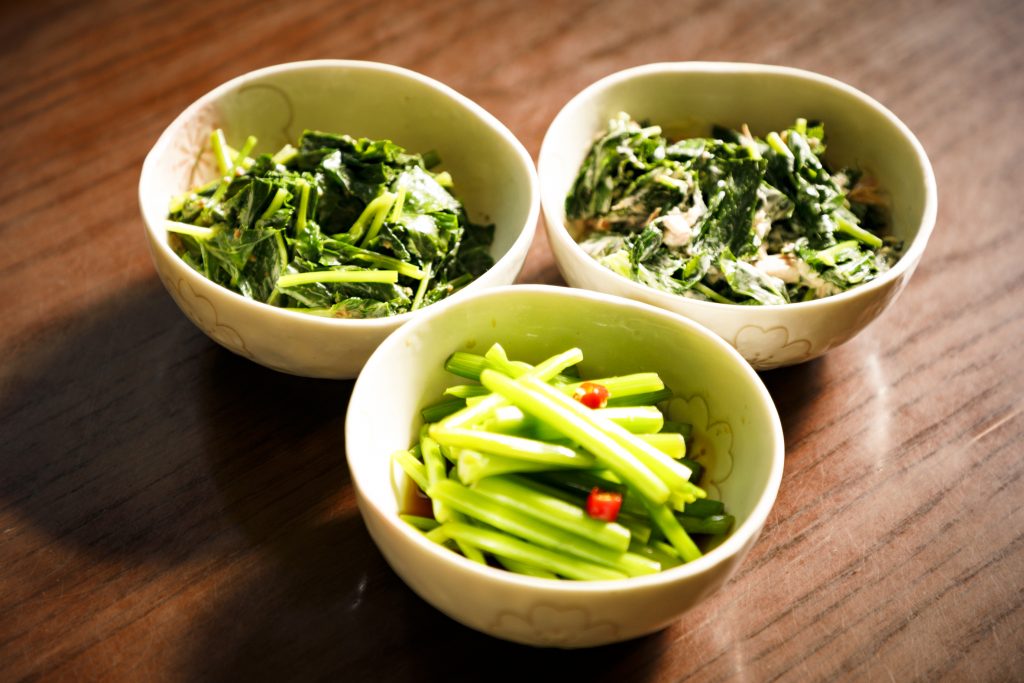
With the boiled stems, adding red island chilies to a kelp-based broth is great as a snack or a side dish. Dressing boiled ashitaba with tuna and mayonnaise is a flavor kids love. Simply mixing in sesame dressing with boiled ashitaba makes a dish that goes perfectly with rice.
“First, chop up the boiled ashitaba and stir-fry it. Then add finely chopped bonito flakes and kelp broth to the pan and stir-fry, and finally add some island seaweed and turn off the heat. This is my go-to dish. I make a big batch using overhanging ashitaba that can’t be shipped and share it with everyone, and they love it. See how well it goes with rice? If you have this in the fridge, you can make it into fried rice in no time. Just stir-fry it with rice. Here’s some for you.”
Digging into the offered fried rice, we noticed how the bitterness and aroma had been mellowed while preserving the essence of the ashitaba taste. With the island seaweed providing a nice flavor accent, we could not stop eating.
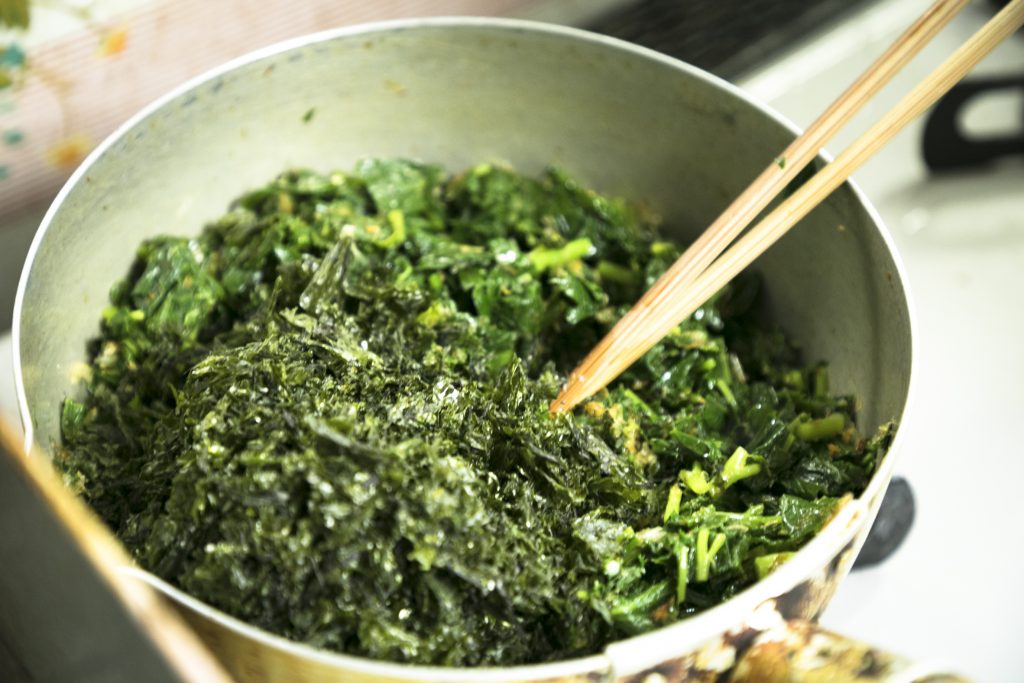
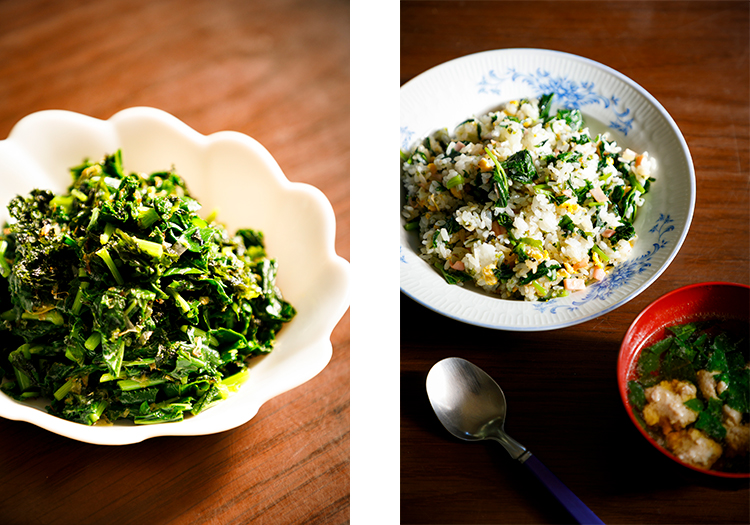
A staple at the Imuras’ is ashitaba stir-fry with ashitaba, bonito flakes, and island seaweed. By adding in and frying chopped ham, egg, and rice, you can make a quick ashitaba fried rice. Add packed spoonfuls of minced tuna from the refrigerator to make ashitaba meatball soup, which has the comforting aroma of ashitaba.
“I use raw ashitaba in regular tempura and mixed vegetables and seafood tempura,” explains Imura. “Today, I chopped them up and mixed them with sweet potatoes. How do you like it?” Biting into the freshly fried tempura, we felt the sweetness of the soft, flaky sweet potatoes and the bracing aroma of ashitaba swell in our mouths. The flavor is mild and unstoppable: perfect as a snack.
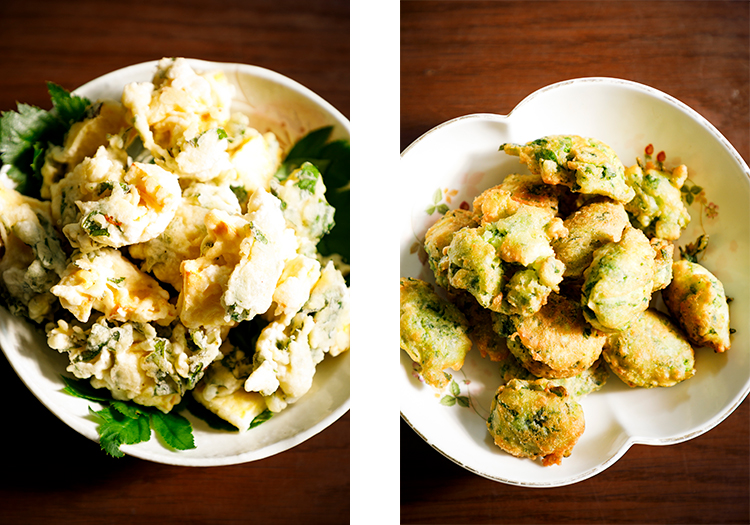
The mixed tempura pieces balance perfectly the sweetness of the sweet potato and the refreshing flavor of ashitaba. Stir boiled and mortar-mashed ashitaba leaves into a pancake mix and then fry in oil. Soon the mix will transform into herb-scented, vibrantly colored donuts.
“When my children come home for a visit, they always request my ashitaba dishes. My son tells me to make ashitaba cake, and my daughter-in-law asks for our classic ashitaba stir-fry to take home as a gift. My daughter requests fried-rice. They all love ashitaba. I don’t eat ashitaba dishes so often personally, because I make them every single day and I’ve gotten tired of them. But I keep on making the dishes no matter how busy I am, because everyone tells me how delicious they are.”
Imura, who’s a bit on the shy side, speaks with some embarrassment, but it’s clear that she is delighted.
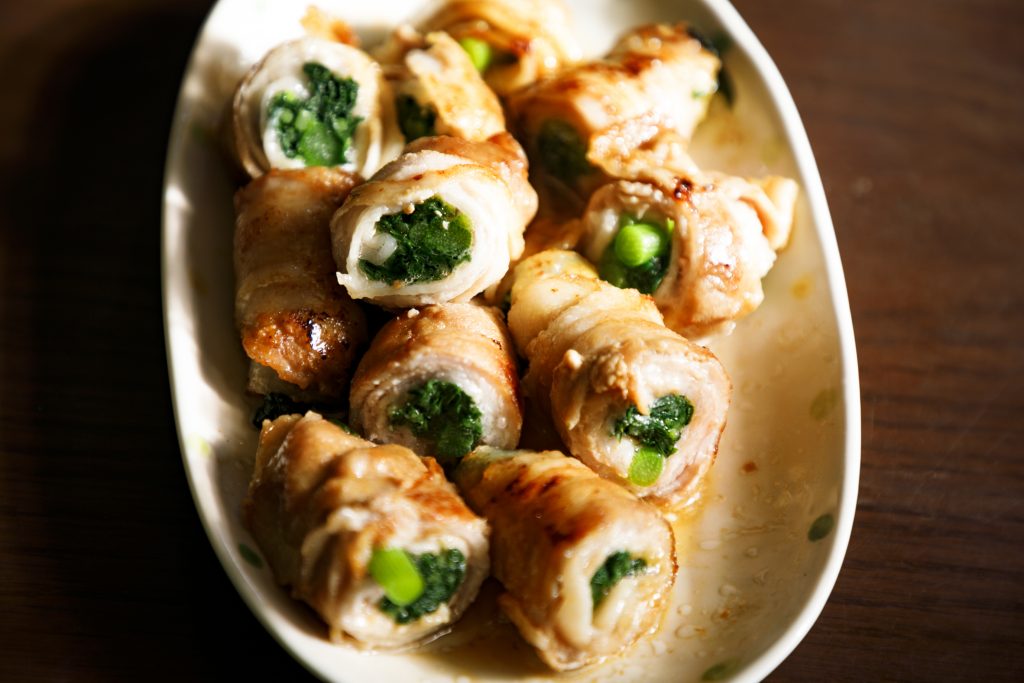
Ashitaba wrapped in meat is a must-have. Ashitaba goes extremely well with all kinds of meat.
“There are still many people who don’t know about the true deliciousness of ashitaba. Some say the leaves are too tough or that the smell puts them off. But I believe they say that because they haven’t properly cooked properly grown ashitaba. If they thoroughly boil the ashitaba I grow and use it in their cooking, they’ll for sure understand how delicious it is,” Imura says emphatically.
Ashitaba today grows wild all over the island, but the changing times pose a threat. As people moved from using firewood and charcoal to electricity and gas for heating and cooking, far fewer people go into the trees on the mountainsides. With the sudden drop in people coming and going around the mountain, fewer ashitaba seeds are being spread around. The plants that once grew on nearly every corner have started to disappear, and now they are only seen around the hannoki alders on the mountainsides.
The extraordinary changes to the natural environment were nearly overlooked amid the dizzying changes in living patterns. The lone signal was the ashitaba. The efforts and passion of farmers like Imura, who have dedicated themselves to preserving ashitaba, are driven by a desire to protect this plant that has been an integral part of island life and a staple of the local diet. It is impossible not to be moved by their commitment.
Ashitaba is a prized and reliable crop for the Izu Islands. A symbiotic relationship exists in which the islanders eat delicious meals and ashitaba gives them vitality.
Ashitaba plants are wonderful companions that live alongside the people on the island.
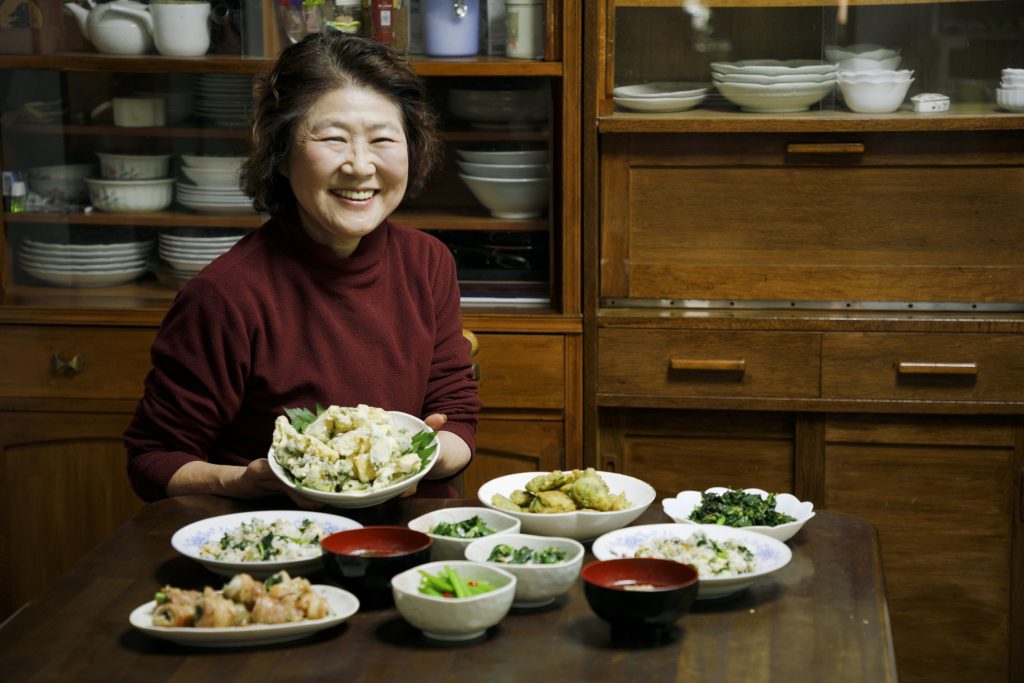
Ashitaba grown by Imura are tender and easy to eat. The care and attention put into cultivating them comes through in the taste.
●Getting to Izu Ohshima
Getting to Izu Ohshima takes an hour and 45 minutes by high-speed jet ferry or six hours by overnight ferry from Tokyo’s Takeshiba Sanbashi Pier. There are also ferry services from Yokohama Port and Kurihama Port in Kanagawa and Atami Port and Ito Port in Shizuoka.
Contact Tokai Kisen at 03-5472-9999 or 0570-005710
URL:https://www.tokaikisen.co.jp/
The annual Izu Ohshima Camellia Festival is underway from January 27 to March 24, 2019.
URL:https://www.tokaikisen.co.jp/tsubaki_festival/